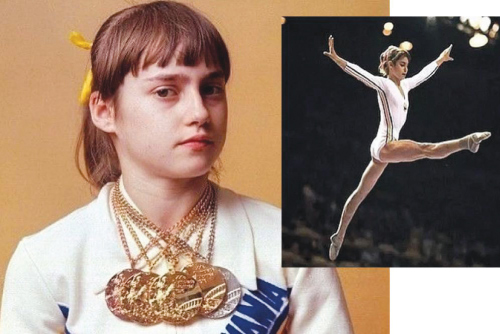
Nadia Comaneci was a Romanian gymnast who became a legendary figure after obtaining perfect 10s in six events at the 1976 Montreal Olympic Games. Comăneci was the first Romanian gymnast to win the Olympic all-around title. She also holds the record as the youngest ever Olympic gymnastics all-around champion.
Nadia Elena Comăneci was born on November 12, 1961, in Onești, a small town in the Carpathian Mountains, in Bacău County, Romania, in the historical region of Western Moldavia.
Her parents separated in the 1970s and her father later moved to Bucharest, the capital. She and her younger brother Adrian were raised in the Romanian Orthodox Church. In a 2011 interview, Nadia’s mother Ștefania said that she enrolled her daughter in gymnastics classes because she was a child who was so full of energy and active that she was difficult to manage.
Flacăra
After years of top-level athletic competition, Comăneci graduated from Politehnica University of Bucharest with a degree in sports education, which gave her the qualifications to coach gymnastics.
 Comăneci began gymnastics in kindergarten with a local team called Flacăra (The Flame), with coaches Duncan and Munteanu.
Comăneci began gymnastics in kindergarten with a local team called Flacăra (The Flame), with coaches Duncan and Munteanu.
In 1970, Comăneci began competing as a member of her home town team and at age nine, became the youngest gymnast ever to win the Romanian Nationals.
International success
In 1971, she participated in her first international competition, a dual junior meet between Romania and Yugoslavia, winning her first all-around title and contributing to the team gold. For the next few years, she competed as a junior in numerous national contests in Romania and dual meets with countries such as Hungary, Italy and Poland. At 11years, in 1973, she won the all-around gold, as well as the vault and uneven bars titles at the Junior Friendship Tournament (Druzhba).
Comăneci’s first major international success came at the age of 13, when she nearly swept the 1975 European Women’s Artistic Gymnastics Championships in Skien, Norway. She won the all-around and gold medals in every event but the floor exercise, in which she placed second.
In the pre-Olympic test event in Montreal, Comăneci won the all-around and the balance beam golds, as well as silvers in the vault, floor and bars. Accomplished Soviet gymnast Nellie Kim won the golds in those events and was one of Comăneci’s greatest rivals during the next five years.
In March 1976, Comăneci competed in the inaugural edition of the American Cup at Madison Square Garden in Manhattan.
She received rare scores of 10, which signified a perfect routine without any deductions, for her vault in the preliminary stage and for her floor exercise routine in the final of the all-around competition, which she won.
During this competition, Comăneci met American gymnast Bart Conner for the first time. While he remembered this meeting, Comăneci noted in her memoirs that she had to be reminded of it later in life. She was 14 and Conner was celebrating his 18th birthday. They both won a silver cup and were photographed together. 
Montreal Olympics
A few months later, they participated in the 1976 Summer Olympics that Comăneci dominated, while Conner was a marginal figure. Conner later said, “Nobody knew me and Comăneci certainly didn’t pay attention to me.” On July 18, 1976, Comăneci made history at the Montreal Olympics. During the team compulsory portion of the competition, she was awarded the first perfect 10 in Olympic gymnastics for her routine on the uneven bars. Omega SA, the official Olympics scoreboard manufacturer, had been led to believe that competitors could not receive a perfect ten and had not programmed the scoreboard to display this score.
Comăneci’s perfect 10 thus appeared as ‘1.00,’ the only means by which the judges could indicate that she had received a 10.
During the remainder of the Montreal Games, Comăneci earned six additional’10s’. She won gold medals for the individual all-around, the balance beam and uneven bars. She also won a bronze for the floor exercise and a silver as part of the team all-around.
Comăneci took over the media spotlight from gymnast Olga Korbut, who had been the darling of the 1972 Munich Games.
Comăneci’s achievements are pictured in the entrance area of Madison Square Garden in Manhattan, where she is shown presenting her perfect beam exercise.
The sport has revised its age-eligibility requirements. Gymnasts must be at least 16 in the same calendar year of the Olympics in order to compete during the Games.
When Comăneci competed in 1976, gymnasts had only to be 14 by the first day of the competition. As a result of changes to age eligibility, Comăneci’s record cannot be broken.
She didn’t let the fact that the only way is down from there to affect her, either. Blessed with exceptional skill, balance and a clean technique, she added two more gold medals to her Montreal one at the 1980 Olympics in Moscow (balance beam and floor), and won two World Championship golds (1978 in the balance beam and 1979 in the Team) and numerous European titles.
Nadia’s Theme
Nadia’s Theme refers to an instrumental piece that became linked to Comăneci shortly after the 1976 Olympics.
It was part of the musical score of the 1971 film Bless the Beasts and Children and originally titled Cotton’s Dream.
It was also used as the title theme music for the American soap opera The Young and the Restless. (TBR)
